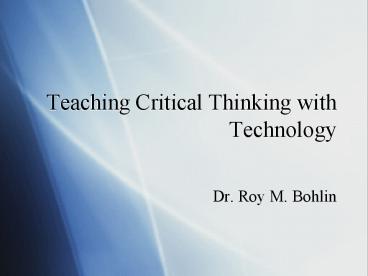Teaching Critical Thinking with Technology - PowerPoint PPT Presentation
1 / 20
Title:
Teaching Critical Thinking with Technology
Description:
Make decisions based upon goals and objectives. ... Dogpile www.dogpile.com. SurfWax www.surfwax.com. Vivisimo? http://vivisimo.com ... – PowerPoint PPT presentation
Number of Views:223
Avg rating:3.0/5.0
Title: Teaching Critical Thinking with Technology
1
Teaching Critical Thinking with Technology
- Dr. Roy M. Bohlin
2
Technology as a Tool
- Make decisions based upon goals and
objectives. If a technology helps achieve the
goal and it fits your philosophy of teaching,
then consider using it. - Teacher centered vs. student centered
3
- The technologies of today bring the tools of
empowerment into the hands and minds of those who
use them. - George Lucas Education Foundation
4
Interactive Clickers
- These interactive devices promote student
decision making in class and can give rapid
feedback. - They can be used with case studies or simulations
for individual or small group decisions.
5
Simulations
- Many disciplines have ready-made computerized
simulations. - Students learning to apply their knowledge to
realistic situations with low risk. - Many simulations promote critical thinking as
students move from novice toward expert.
6
Critical Thinking and the Internet
- URLs What's in an address?
- Web addresses can provide clues for the
reliability of information. The .edu domain is
generally assumed to be reliable, while .com is
seen as commercial and less reliable. - Exceptions?
- Washington International University?http//www.was
hint.edu/?example of a diploma mill, that uses
the .edu domain - Carson Lee's Home Page?http//www.acm.vt.edu/jche
n/?.edu domain using tilde to designate a
student's page - Psych Central?http//psychcentral.com/?.com used
for a non-profit Web site produced by a
psychologist
7
Authority
- Can we trust the source? To be trusted, documents
on the web should state their authors. What
constitutes an expert? Many non-experts have
created valuable web sites. - Wind Power?http//en.wikipedia.org/wiki/Wind_power
?Wikipedia, this is written by an anonymous
author or authors - Henry James scholar's Guide to Web
Sites?http//www2.newpaltz.edu/hathawar/cutting/?
expertise on Henry James -- no expertise on the
Web and searches
8
Dates
- When was it written or updated? Dates may not
accurately reflect the content. - UBC Humanists' Society?http//www.ams.ubc.ca/clubs
/humanist/?last updated 2000 - Endangered Species?http//agham.asti.dost.gov.ph/5
th/inside/science/article.html?no date on page
9
Internet Searches
- Using search engines (especially advanced
searching) activates multiple areas of the brain. - Meta-search engines
- Dogpile www.dogpile.com
- SurfWax www.surfwax.com
- Vivisimo? http//vivisimo.com/
- Copernic Agent www.copernic.com
10
WebQuests
- A WebQuest is a highly-structured
inquiry-oriented lesson format in which most or
all the information that learners work with comes
from the web. - The model was developed by Bernie Dodge at San
Diego State University. - http//www.webquest.org/index.php
11
Components of a WebQuest
- Introduction
- Task
- Process
- Evaluation
- Conclusion
- As with most Inquiry, the key is to have an
interesting problem to solve.
12
Less Structured Quest
- When students are ready, they can be given
interesting problems without the full structure.
It can be open ended or open process. - It can be directed inquiry or self-directed.
13
Research vs. Web Search
- Make sure that students learn the huge
difference between Research and Web Search.
14
Probeware
- In the sciences, these devices can be
programmed to gather and graph data. This gives
more time for students to critically analyze the
results and hypothesize. - Temperature
- pH
- Brightness
- Velocity
15
Blogs
- This can be a can of worms, but using blogs
can promote Student Philosophers. - Critical thinking can be promoted with the
writing and feedback given, if the focus is on
truly critical analysis.
16
Databases/Spreadsheets
- Real data
- Sorting and/or filtering
- Graphing
- Seeking patterns and relation-ships
- Answering important questions
17
Video Case Studies
- Multimedia bring the case alive.
- Can be used in class or streamed for assignments
outside of class. - Multiple sources can add depth to the case and
the analysis. - Current news shows can be a source
18
Student Created Projects
- Websites
- Video Projects
- Podcasts
- Wikis
- Much more..
19
Educause Top Teaching-With-Technology Challenges
- Creating learning environments that promote
active learning, critical thinking, etc. ? - Developing 21st-century literacies (informa-tion,
digital visual) among students faculty.? - Reaching and engaging todays learners.?
- Encouraging faculty to adopt innovate with new
technology for teaching learning.? - Advancing innovation in teaching learning with
technology in an era of budget cuts.
20
- Questions? Comments?
- Thank You!































